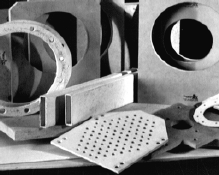
REFRACTORY SHEET TYPE RS-100 MACHINING GUIDELINES
This manual is intended to show some of the ways of fabricating Refractory Sheet Type RS-100 products. These methods range from volume production to hand work in the field. These recommendations summarize the results of ZIRCAR experience and include specific recommendations for tools and handling. In many instances, commonly available tools are indicated; cutting speeds and tool life data are provided where important. Selection of tools will depend on thickness and volume of material to be processed as well as local conditions. RS-100 is an engineered ceramic reinforced ceramic matrix laminate which as been cured and pre-fired to produce a stable high strength material. It is well suited for a range of applications where its refractoriness, high strength and electrical insulation value is useful. For more information on RS-100, see ZIRCAR Technical Bulletin #ZRCI-001.
RS-100 is available in standard and custom sizes as follows:
STRAIGHT CUTS
EQUIPMENT SELECTION
RS-100 can be cut with a variety of equipment ranging from large stationary to hand held saws. Large circular saws, such as a radial arm saw, are recommended for continuous and volume cutting operations. These types of saws afford maximum accuracy for short or long straight cuts and are easily handled by one person. For intermittent shop and field cutting portable circular saws, band saws, saber saws, jig saws, hack saws, or various other types of equipment may be used for minor cuts of no more than a few linear feet and for minor field adjustments. These type of saws are not suitable for extensive use because of the slow cutting rate and short tool life which may result in excessive chipping and edge fraying. It may also be difficult to obtain a good straight edge.
TOOL SELECTION
Carbide tipped tooling is the only practical answer to long tool life when cutting RS-100 sheet. Other blade types are adequate when cutting a small number of thinner boards; but will not produce quality cuts for any length of time.
The advantages of carbide tipped tooling are as follows:

RS-100 can be readily fabricated into custom shapes & sizes
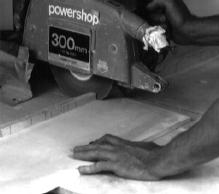
Circular saws are recommended for continuous & volume cutting operations
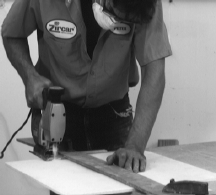
A jigsaw is useful for minor straight & curved cuts of a few linear feet
Over time, increased chipping can be expected to occur as blade wear increases. As maximum wear is approached, feed will become noticeably difficult and edge chipping more abundant. Blades with 60 to 100 teeth in a triple chip design have exhibited the longest life needing the fewest tip replacements.
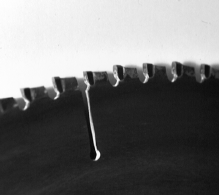
Carbide tip saw blades with triple chip tooth design have shown the longest life, needing the least number of tip replacements.
For high quality edges with minimal chipping, re-sharpening of a 16", 100 tooth, triple chip, carbide tipped blade should be considered at the following intervals for the specified sheet thickness.
Sheet Thickness Linear Feet Cut
1/4” 1800-2400
1/2” 800-1200
3/4” 600-900
1” 300-400
Since the life of carbide tipped blades is sensitive to its diameter and to the rigidity of the saw, it can be expected that smaller blades used in hand held circular saws will have a shorter life than might otherwise be predicted.
SET UP
When using large stationary saws to cut straight edges through RS-100 boards, standard set up procedures for normal fabrication operations will produce quality edges. As when cutting any material, it is important to securely position the board on the table prior to cutting. The material should be fed into the blade at a normal cutting speed rather than force feeding where the blade might jam. For low volume cutting of thin RS-100 boards, a clean edge can be obtained by using a circular saw against a straight edge. Solid support should always be provided, especially when using hand tools. If the dimensional tolerance of the edge is not critical, band saws, circular saws with a saw guide attachment, saber saws, or other hand held saws are adequate. When cutting RS-100, dust masks should always be worn and an adequate dust collection system should be available, especially when using circular saws that tend to scatter dust particles.
OPERATION
Typical operating parameters for a large radial arm saw are:
Feed rate:
Sheet Thickness Feed ft/sec
1/4” 5
1/2” 4
3/4” 3
1” 2
Note: Feed rates are for a new or newly sharpened blade. Rates will decrease dramatically with linear footage cut. High speed steel saw blades may be adequate when performing a minimal amount of cuts but should otherwise be avoided. For band saws, a tungsten carbide grit edge gullet blade will more readily clear dust from the cutting area. These tools are not suitable for extensive cutting operations because of the slow cutting rate and short tool life. Whenever possible, carbide tipped tooling should be used.
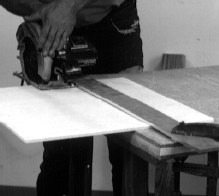
Solid support should always be provided when working with hand tools
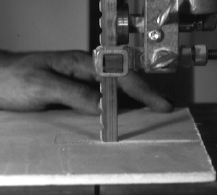
A gulleted tungsten carbide grit edge blade is recommended when using a band saw
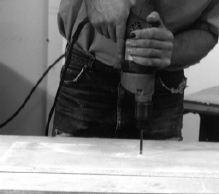
Hand held drills can be used for low volume & field operations
TOOL SELECTION
Solid carbide or carbide tipped drill bits are recommended for drilling holes in all thicknesses of RS-100 Sheet. High speed steel may be used for very low volume drilling, but have been known to deteriorate after drilling as few as thirty holes in 1/4" thick RS-100. Solid carbide and carbide tipped drills are available up to approximately 1” diameter. Multi-tooth carbide tipped hole saws are available up to approximately 3” diameter. For larger holes, it will be necessary to use a milling machine or router with template.
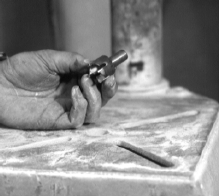
Carbide tipped core drills are recommended for large diameter holes
SET UP
Because RS-100 is a laminate, care must be taken to prevent fraying on the underside of the board when drilling. The best way to avoid this and get a clean hole is to use a back up plate such as a piece of hard board or scrap RS-100. Care should also be used to avoid surface damage if clamps or templates are to be used. Drilling speed will depend on the thickness of the sheet drilled. In all cases a slow constant pressure should be exerted on the bit. When drilling through thick boards (3/4" to 1"), slow penetration will be necessary to insure that all the loose material is ejected from the hole. In the event of dust build-up, the bit should be backed out of the hole allowing it to clear. Drilling should be resumed at a slower speed. It may be necessary to back out regularly to clear the material. Upon completion, the bit should be brought completely through the board 1/4” or more into the back up plate.
OPERATION
For a single drill press operating parameters are as follows:
CUSTOM CUTS
EQUIPMENT SELECTION
Mills and routers are best suited for fabricating custom cuts such as large holes, discs, grooves, and curves. A milling machine equipped with a rotary table is ideal for volume work. A router and template will also produce accurate cuts. Bayonet and jigsaws can be used for occasional applications where irregular shaped cutouts are required.
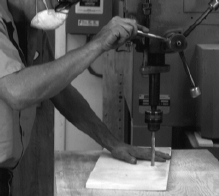
A drill press should be used to assure perpendicular holes
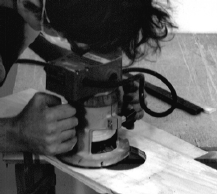
Holes & discs can be fabricated in RS-100 using hand routers
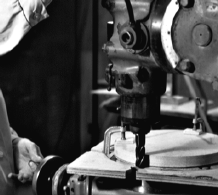
A drill press should be used to assure perpendicular holes
TOOL SELECTION
Solid carbide or carbide tipped end mills and router bits produce the best results. A four (4) fluted end mill design works best. Two (2) fluted end mills are adequate for through cutouts but will leave a ridge in grooves. The size of the end mill is not critical, the larger the mill used the faster the cutting process. High-speed steel can be used for low volume work but will burn out quickly. Tungsten carbide grit edge blades are recommended for use with jig, saber and bayonet saws.
SET UP
When using large stationary mills and routers for cuts such as holes and discs, the use of a back up plate will prevent fraying on the underside of the board. A piece of hard board or scrap RS-100 is adequate. Plywood or another rigid material should also be used to protect the board from surface damage when clamping. For high quality cuts, it is necessary to use a stepwise procedure making a number of passes through the RS-100 board to complete the cut. How many will depend on the depth of the groove, or for holes and disc, the thickness of the board. The best results are seen when the cut is brought down 1/8 of an inch or less into the board on each pass. If brought down too fast a spiral groove will be evident in the final cut. The quality of the cut also depends on the feed rate a slow steady rate insures a better cut. A good rule of thumb is to feed the board into the mill or router no faster than 12 inches per minute. Hand held routers can be used to cut holes and discs in thinner RS-100 boards but are not practical for volume work because the cut cannot be made without changing the bit several times. When using hand routers, the RS-100 board and template should be secured on a table with the section to be cut hanging over the edge. In this case it is not necessary to use a back up plate. Bit selection will depend on the thickness of the template used and on the thickness of the RS-100 board. The first bit should not cut into the RS-100 board more than 1/8 inch, the second bit should not extend more than 1/4 inch into the board, and so on until the desired cut is complete. This stepwise procedure is important because too long of a bit in the initial cutting stages will make it difficult to handle the router and very likely break the bit.
OPERATION
Operating parameters for a milling machine equipped with a rotary table are:
MECHANICAL FASTENING
Standard tapping procedures using high-speed steel ground thread hand taps and a tap wrench will easily fabricate threads in RS-100 boards when mechanical fastening with screws or bolts is required. After drilling a hole according to standard tap drill charts, tapping is best accomplished by rotating the tap 1/2 turn into the board than backing out 1/2 turn. This procedure will clear chips and dust out of the hole and produce quality threads.
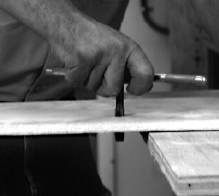
Threads are easily fabricated in RS-100 using hand taps
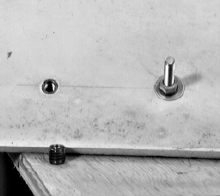
Self-locking thread inserts are useful to extend the bolting utility of RS-100
PULLOUT STRENGTH (lbs.)
Bolt/Screw Pilot Drill Board Thickness(in.)
Size Size(in.)* 1/4 3/8 1/2
3/8-13 11/32 146 191 376
1/4-20 7/32 81 146 268
#10 S.M. 1/8 88 133 263
#12 S.M. 5/32 110 196 45
*It is recommended to use the minimum size pilot drill required to maximize cut thread size.
Care should be taken to keep proper alignment of the tap wrench throughout the procedure to insure straight threads. The bolt or screw can then be screwed into the board. If the integrity of the thread is critical or if screws or bolts are to be removed and replaced a number of times, it is recommended that a self locking thread insert be used. Inserts are also useful to repair stripped threads. As can be expected, screw failure will more readily occur in thinner boards where there are fewer threads. The following table shows the pullout strength (pounds) required causing thread failure in various board thicknesses. Screws can also be screwed directly into thinner boards after drilling without tapping. This is not suggested for thicker boards because of the difficulty in obtaining a straight hole. Self-tapping screws and bolts, cinch anchors, expansion anchors, or other forms of compression fasteners should not be used with RS-100. Chips and dust particles cannot be cleared from the hole with this type fastener, compression within the board could cause internal delaminating, weakening the integrity of the board.
SAFETY CONSIDERATIONS
Dust
Dust generated by sawing, milling, and other machining operations with RS-100 fall within the category of respirable nuisance dusts rather than toxic dusts (reference: OSHA Standard 29 CFR Part 1910, Subpart 2). Although it is considered a respirable dust and causes no unusual hazards, the dust should be controlled in accordance with normal practices for good shop safety and housekeeping which includes taking precautions against possible overexposure. Local ventilation and dust collection should be used to minimize dust concentrations in worker breathing zones. If necessary, respirators in compliance with OSHA standard should also be worn. While there are no unique or special hazards associated with normal use and handling of Refractory Sheet Type 100, ZIRCAR has developed a substantial body of information relative to good safety practices. See ZIRCAR Material Safety Data Sheet No. MSDS-5, for more information.
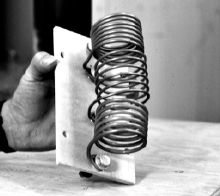
Heating coils can be bolted directly to RS-100